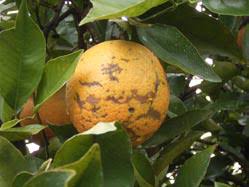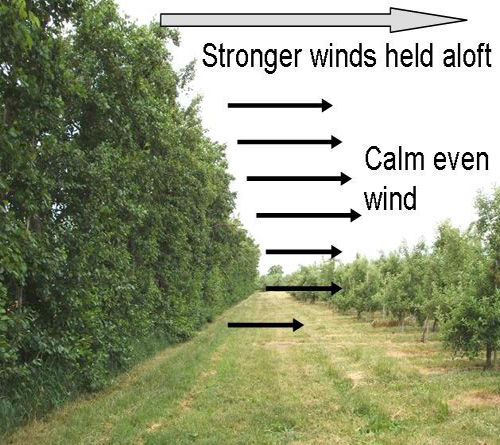Citrus trees require a protected environment in order to produce high yields of top quality fruit. Wind protection may be provided in various ways – a row or rows of trees around the planting, single rows within the orchard, plantings of tall grasses between rows of newly planted trees, or construction of an artificial windbreak.

Types of Damage
The following are examples of the damage caused by wind:
- markedly reduced growth rates
- reduced yields
- root damage in young trees
- bark damage at ground level
- bent or fallen trees
- few or no fruit on the windward side
- lesions on the leaves and stems and fruit scarring
- limb breakage
- fallen fruit.
Some of these losses are readily measurable, while others do not become apparent until harvest. There are other invisible effects from wind, including increased evaporation and transpiration resulting from reduced relative humidity and temperatures, from excessive wind movement over the trees. The many surveys and quality control reports that have been produced over the years from packing sheds indicate that rind blemish accounts for most downgrading. Results from a case study following this report indicate that 75% of major blemishes and 87% of minor blemishes of navel oranges in Waikerie, South Australia in 2005 were due to wind damage.

The geographical location of the citrus planting will partly determine the type of windbreak required. Each citrus growing area and each planting will have specific windbreak requirements.
Benefits of windbreaks
From the published literature some of the quantifiable benefits of wind protection have included:
- Improved Grade 1 packouts. Grade 1 fruit was 67% in protected blocks with 40% in unprotected blocks (Revelant, 1987) and 53% in protected blocks with only 30% in unprotected blocks (Freeman, 1976).
- Improved yields due to increased fruit set and size. Yield increases of between 13% and 16% (Freeman, 1976).
- Increased tree canopy growth of between 8% and 12% (Freeman, 1976).
Some additional advantages of well designed windbreaks include:
- Reduced wind speed
- Reduced spray drift and improved spray coverage
- Reduced wind scarring of fruit
- Increased and earlier yields
- Reduced water loss from evaporation by up to 30%
- Reduced soil erosion
- Slightly higher temperatures in winter
- Reduced dust on plants, thereby increasing photosynthesis and reducing the damage caused by scale insects and mites
- Provides a habitat for insects and pollinators


For full document, you can download here: Windbreaks for Citrus

